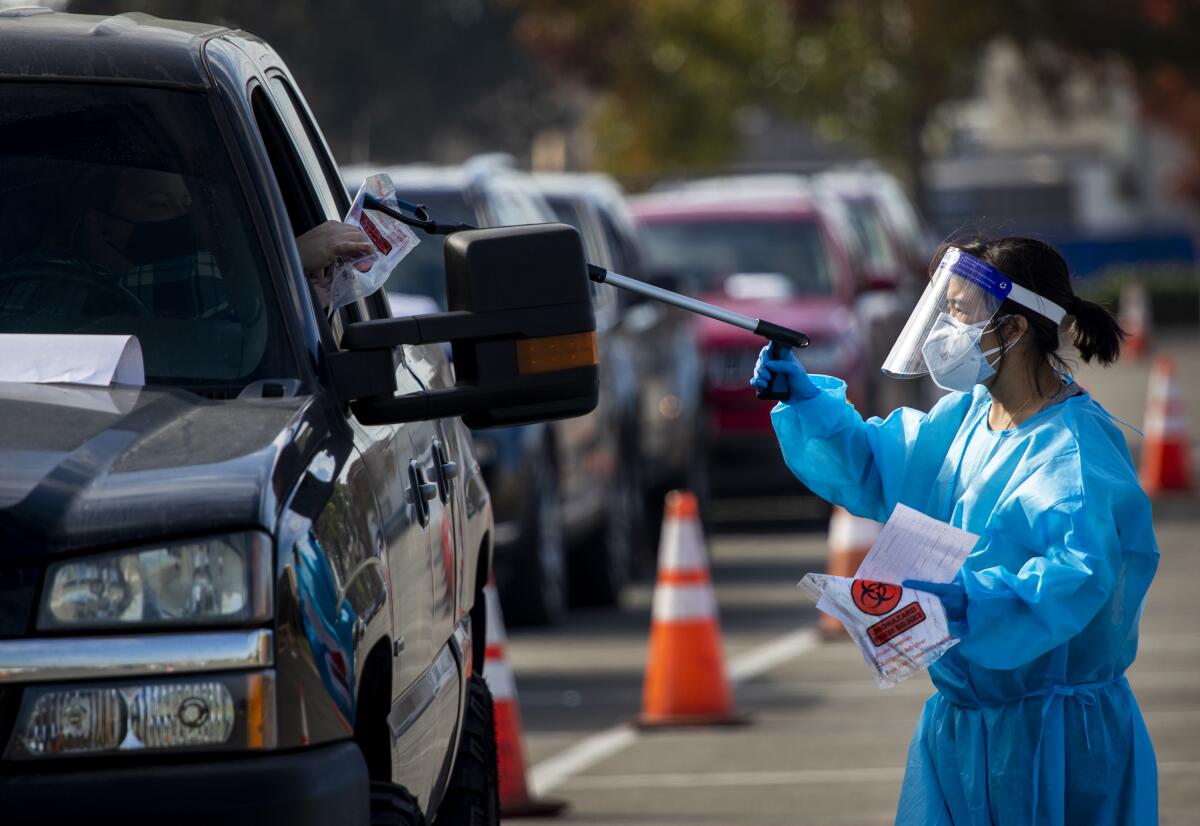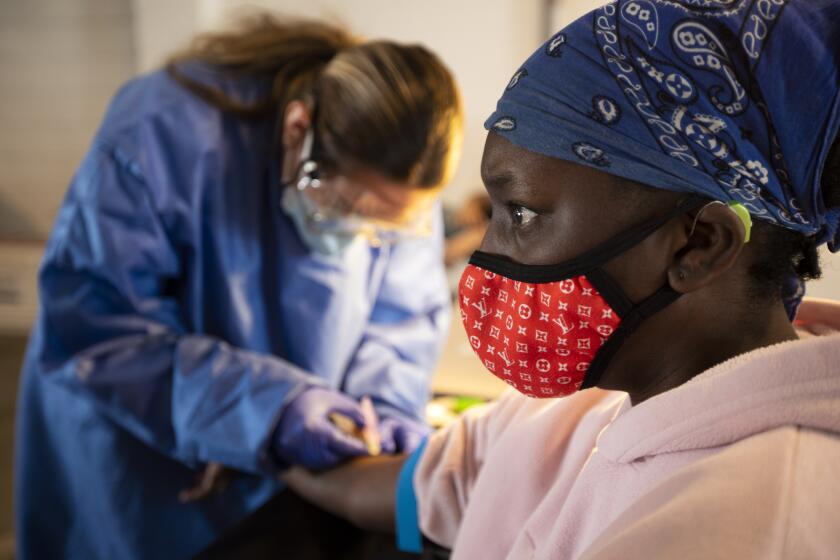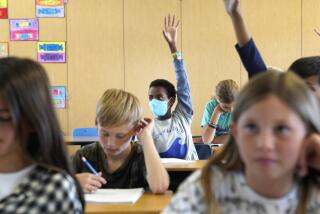California hits 1 million coronavirus cases as L.A. County urges travel quarantine

- Share via
Coronavirus infections in California are racing upward at a level not seen since the summer, with the state surpassing 1 million cases on Thursday, and health officials are warning dire action must be taken to stop the spread of the illness.
If the surge continues in Los Angeles County, “additional actions” could become necessary to bring the rate of transmission back under control, Public Health Director Barbara Ferrer said.
Though she didn’t elaborate on what potential new measures could be implemented, Ferrer emphasized that L.A. County remains on a knife’s edge and that everyone needs to do their part to keep conditions from worsening. The warning comes as California joins Texas in becoming the only two states to have officially surpassed 1 million infections.
Gov. Gavin Newsom has announced a stay-at-home order affecting most of California.
“We all need to act now,” she said during a briefing. “The actions we take today, tomorrow and next week have tremendous impact on the health and well-being of many, many people across the county. If, collectively, we fail to stop the acceleration of new cases, we will have no choice but to look at additional actions.”
Thanksgiving is shaping up to be a particularly painful choice. The county is recommending that residents don’t travel out of state for the holiday and, if they do, that they quarantine for 14 days upon their return.
“If you are going to travel — which we are recommending you not do, we are actually recommending this Thanksgiving be a stay-at-home Thanksgiving — but if you are going to travel, we do ask when you come back that you quarantine for 14 days,” Ferrer said. “And the tighter you can restrict your activities over those 14 days, the better off we all are.”
Though the idea of not seeing family and friends after such a difficult year may strike some as untenable or unreasonable, health officials have repeatedly warned that gathering with those outside your household heightens the risk of transmitting the disease.
Ferrer acknowledged it was a sacrifice, saying she won’t get to see her grandchildren this year because they live in another state.
“Like all of you, I wish things were really different. But they’re not,” she said. “And my feeling is I don’t want to be one of the people that’s contributing to not only increasing cases that restrict our ability to continue with our recovery journey, but increasing cases that could result in other people getting sick and even dying.”
California has generally banned large gatherings, and says smaller ones of no more than three households may be held outdoors with limitations, including time limits and requirements that attendees physically distance and wear face coverings.
A coronavirus outbreak tied to a wedding reception caused 177 infections and 7 COVID-19 deaths. It shows why health officials are nervous about holiday gatherings.
L.A. County, like California as a whole, is seeing a renewed spike in coronavirus infections that currently shows no signs of dissipating. As of Nov. 3, the average number of daily cases in the county was 1,464 — up from 988 a month prior, Ferrer said.
Recent counts have been even higher. On Thursday, Ferrer reported 2,533 new cases.
The county is also starting to see hospitalizations climb. On Thursday, there were 953 COVID-19 patients in hospitals countywide — up from 777 on Nov. 2, Ferrer said.
Given that it usually takes a few weeks for a crush of cases to result in a corresponding increase in hospitalizations and deaths, Ferrer said that “we most likely haven’t yet seen the full consequence of the surge in cases we recently experienced.”
“While we’ve made impressive strides in caring for people who are ill with the virus, this much of an increase in cases may very well result in tremendous suffering and tragic deaths down the road,” she said.
So far, the county has not seen an uptick in deaths corresponding to the surge. In fact, as of Nov. 2, the average number of deaths per day in the county was 10, which “is the lowest number that we have seen since the very early days of the pandemic,” Ferrer said.
Still, she emphasized, “it’s going to take all of us to avoid increased heartbreak.”
As California approaches 1 million COVID-19 cases, officials fear more hospitalizations and deaths, and debate more intense measures to slow the rate.
California’s weekly cases have doubled in the past month. The Golden State has averaged about 6,300 new cases a day over the last week; that number was about 3,200 a month ago.
The proportion of tests coming back positive has also crept up to 4.4% over the last seven days, a rate not seen “since the end of August, early September,” California Health and Human Services Secretary Dr. Mark Ghaly said this week.
Hospitalizations are up too. The number of COVID-19 patients statewide is 3,300, up roughly 50% in the last month, according to state data. There are 913 patients in intensive care, a 39% increase over the last 14 days.
An average of 42 Californians have died each day over the last week, and the state’s total death toll now exceeds 18,100.
California’s climb comes as a coronavirus wave of unprecedented size crashes over the United States. The country as a whole reported more than 144,000 new cases on Wednesday, an all-time high, according to the COVID Tracking Project.
Hospitalizations have also reached record levels nationwide and, on average, more than 1,000 Americans have fallen victim to the virus daily over the last week.
Dr. John Swartzberg, an infectious disease expert at UC Berkeley, likened humans to fuel and the virus to fire.
“As long as there is fuel around, the virus is going to get there,” he said. “The virus doesn’t know whether it is Nevada, California or Wisconsin. … You are going to see this virus go everywhere, and there is plenty of fuel in California.”
He said he believes the coronavirus is likely to swamp California in December and parts of the state economy will have to be shut down.
“Within a month after Thanksgiving, the number of cases is going to be up significantly,” Swartzberg said. “California is going to be very worried, and we will start to see things close down.”
In the unprecedented regression, San Diego County is among those that slide backward in the state’s reopening tiers Tuesday.
Eleven counties regressed to more restrictive tiers in California’s coronavirus reopening system just this week — subjecting them to tighter limitations on businesses and other public facilities. Ghaly said more are at risk of backsliding if conditions don’t improve.
“We anticipate, if things stay the way they are, that between this week and next week, over half of California counties will have moved into a more restrictive tier,” he said during a briefing Tuesday. “And so that certainly is an indication that we’re concerned and that we have to keep a close watch on what’s happening.”
In Alameda County — which was not among those that moved into a more restrictive tier this week — officials said they would hold off on additional reopenings, citing increases in COVID-19 cases and hospitalizations.
“We must exercise caution and prepare to move quickly to protect our residents and hospitals from rising cases of COVID-19,” county Health Officer Dr. Nicholas Moss said in a statement. “We continue to closely monitor the situation. If necessary, we will restrict activities that are higher risk for spreading COVID, including those in which people gather indoors without masks.”
Health officials and experts have said residents need to use all the infection-prevention tools available to keep California’s surge from reaching the skyscraping heights seen elsewhere. Those include wearing masks in public, regularly washing your hands, keeping physical distance from those you don’t live with and staying home when you’re sick.
It also means, as Sacramento Mayor Darrell Steinberg said this week, that residents should “for God’s sake, stop gathering.”
Officials have increasingly pointed to gatherings as a major potential source of infections, as residents are less likely to take precautions when they’re around people they know and trust.
That’s particularly worrying with the holidays on the horizon.
Can you have Thanksgiving during the COVID-19 pandemic? Researchers have created an interactive map that estimates the risk you’ll face in any county.
Steinberg acknowledged in a statement posted on Twitter that “it will be harder to resist gathering as the days get cold and dark” and that “we are up against the holidays, up against friend and family traditions to be together.”
But he issued a challenge to residents of Sacramento County, which moved this week into the state’s most restrictive reopening tier: “Make new traditions, find safe new ways to be together virtually, to be safe and to be patient.”
“We have it in our power to reverse this trend,” he said. “There is everything right about redefining what holiday cheer means in 2020. It means putting public health first. Everything else we cherish depends on this.”
Times staff writer Maura Dolan contributed to this report.
More to Read
Sign up for Essential California
The most important California stories and recommendations in your inbox every morning.
You may occasionally receive promotional content from the Los Angeles Times.















